Approaches to Multi-Objective Optimization and Assessment of Green Infrastructure and Their Multi-Functional Effectiveness: A Review
Abstract
1. Introduction
2. Methodology
3. Multi-Functional Effectiveness of GI
3.1. Functions and Benefits
3.2. Assessment of the Effectiveness
3.3. Literature Analysis
4. Multi-Objective Optimization Methodology
4.1. Spatial Scale
4.2. Optimization Objectives
4.3. Decision Variables
4.4. Optimization Method
4.5. Optimization procedure
- Determination of the scale at which the optimization program will operate.
- Identifying objectives of the optimization program, selecting decision variables, and constraints of the optimization scheme.
- Choose original decision variables of GI.
- Using the SWMM models to assess the hydrological effectiveness of GI scheme.
- Run NSGA-II. The SWMM model and the optimization algorithm are intercycled to realize automatic searching of the optimal design parameters.
- Optimization complete and generate the Pareto front that corresponds to a set of optimal solutions, so-called nondominated solutions.
4.6. Literature Analysis
5. Future Research Directions
5.1. Enhancing Integrated Multi-Objective-Based Assessment and Optimization
5.2. Improving Life Cycle Analysis (LCA) and Life Cycle Cost (LCC)
5.3. Integrating Benefits of GI Based on Future Uncertainties
5.4. Developing Integrated Green–Gray Infrastructure
6. Conclusions
- (1)
- A multi-functional conceptual framework for GI involving hydrology, energy, climate, environment, ecology, and humanities is proposed. This framework expresses the functions of GI, as well as the direct benefits and co-benefits through GI functions. Although we already have a better understanding of the multi-functional effectiveness of GI, there is no consensus on how to measure the integrated multi-functional effectiveness of GI.
- (2)
- A number of research papers on the multi-objective optimization of GI have been summarized. The primary objective is to maximize the integrated benefits for decision-making on GI. The optimization method is usually coupled with an effectiveness evaluation model and an optimization algorithm under a specific spatial scale and optimization goal. The pareto front is employed to find the optimal variables for GI decision-making including type, size, and location.
Author Contributions
Funding
Conflicts of Interest
References
- Pumo, D.; Arnone, E.; Francipane, A.; Caracciolo, D.; Noto, L. Potential implications of climate change and urbanization on watershed hydrology. J. Hydrol. 2017, 554, 80–99. [Google Scholar] [CrossRef]
- Hirabayashi, Y.; Mahendran, R.; Koirala, S.; Konoshima, L.; Yamazaki, D.; Watanabe, S.; Kim, H.; Kanae, S. Global flood risk under climate change. Nat. Clim. Chang. 2013, 3, 816–821. [Google Scholar] [CrossRef]
- Donat, M.G.; Lowry, A.L.; Alexander, L.V.; O’Gorman, P.A.; Maher, N. More extreme precipitation in the world’s dry and wet regions. Nat. Clim. Chang. 2016, 6, 508–513. [Google Scholar] [CrossRef]
- Oudin, L.; Salavati, B.; Furusho-Percot, C.; Saadi, M. Hydrological impacts of urbanization at the catchment scale. J. Hydrol. 2018, 559, 774–786. [Google Scholar] [CrossRef]
- Liu, J.H.; Wang, H.; Gao, X.R.; Chen, S.; Wang, J.; Shao, W. Review on Urban Hydrology (in Chinese). Chin. Sci. Bull. 2014, 59, 3581–3590. [Google Scholar]
- Wang, H.; Jia, Y.W. Theory and study methodology of dualistic water cycle in river basins under changing conditions (in Chinese). J. Hydraul. Eng. 2016, 47, 1219–1226. [Google Scholar]
- Yang, P.; Ren, G.; Yan, P. Evidence for a strong association of short-duration intense rainfall with urbanization in the Beijing urban area. J. Clim. 2017, 30, 5851–5870. [Google Scholar] [CrossRef]
- Dong, X.; Guo, H.; Zeng, S. Enhancing future resilience in urban drainage system: Green versus gray infrastructure. Water Res. 2017, 124, 280–289. [Google Scholar] [CrossRef]
- Aryal, R.; Vigneswaran, S.; Kandasamy, J.; Naidu, R.; Vigneswaran, S. Urban stormwater quality and treatment. Korean J. Chem. Eng. 2010, 27, 1343–1359. [Google Scholar] [CrossRef]
- Montalto, F.; Behr, C.; Alfredo, K.; Wolf, M.; Arye, M.; Walsh, M. Rapid assessment of the cost-effectiveness of low impact development for CSO control. Landsc. Urban Plan. 2007, 82, 117–131. [Google Scholar] [CrossRef]
- Yu, D.; Xun, B.; Shi, P.; Shao, H.; Liu, Y. Ecological restoration planning based on connectivity in an urban area. Ecol. Eng. 2012, 46, 24–33. [Google Scholar] [CrossRef]
- European Commission (EC). Green Infrastructure (GI)-Enhancing Europe’s Natural Capital; European Commission: Brussels, Belgium, 2013. [Google Scholar]
- US Environmental Protection Agency (USEPA). What is Green Infrastructure? Available online: https://www.epa.gov/green-infrastructure/what-green-infrastructure (accessed on 5 September 2020).
- Li, C.; Peng, C.; Chiang, P.; Cai, Y.; Wang, X.; Yang, Z. Mechanisms and Applications of Green Infrastructure Practices for Stormwater Control: A Review. J. Hydrol. 2019, 568, 626–637. [Google Scholar] [CrossRef]
- Spatari, S.; Yu, Z.; Montalto, F.A. Life cycle implications of urban green infrastructure. Environ. Pollut. 2011, 159, 2174–2179. [Google Scholar] [CrossRef] [PubMed]
- Wang, H.; Mei, C.; Liu, J.; Shao, W. A new strategy for integrated urban water management in China: Sponge city. Sci. China Technol. Sci. 2018, 61, 317–329. [Google Scholar] [CrossRef]
- Fletcher, T.D.; Shuster, W.; Hunt, W.F.; Ashley, R.; Butler, D.; Arthur, S.; Trowsdale, S.; Barraud, S.; Semadeni-Davies, A.; Bertrand-Krajewski, J.-L.; et al. SUDS, LID, BMPs, WSUD and more—The evolution and application of terminology surrounding urban drainage. Urban Water J. 2014, 12, 525–542. [Google Scholar] [CrossRef]
- Hansen, R.; Pauleit, S. From Multifunctionality to Multiple Ecosystem Services? A Conceptual Framework for Multifunctionality in Green Infrastructure Planning for Urban Areas. AMBIO 2014, 43, 516–529. [Google Scholar] [CrossRef]
- Jayasooriya, V.M.; Ng, A.W.M. Tools for modeling of stormwater management and economics of green infrastructure practices: A review. Water Air Soil Pollut. 2014, 225, 2055. [Google Scholar] [CrossRef]
- Kuller, M.; Bach, P.M.; Ramirez-Lovering, D.; Deletic, A. Framing water sensitive urban design as part of the urban form: A critical review of tools for best planning practice. Environ. Model. Softw. 2017, 96, 265–282. [Google Scholar] [CrossRef]
- Eckart, K.; Mcphee, Z.; Bolisetti, T. Performance and implementation of low impact development—A review. Sci. Total Environ. 2017, 607–608, 413–432. [Google Scholar] [CrossRef]
- Zhang, K.; Chui, T.F.M. A comprehensive review of spatial allocation of LID-BMP-GI practices: Strategies and optimization tools. Sci. Total Environ. 2018, 621, 915–929. [Google Scholar] [CrossRef]
- Vandermeulen, V.; Verspecht, A.; Vermeire, B.; Van Huylenbroeck, G.; Gellynck, X. The use of economic valuation to create public support for green infrastructure investments in urban areas. Landsc. Urban Plan. 2011, 103, 198–206. [Google Scholar] [CrossRef]
- Dandy, G.C.; Di Matteo, M.; Maier, H.R. Chapter 15—Optimization of WSUD Systems: Selection, Sizing, and Layout. In Approaches to Water Sensitive Urban Design; Sharma, A.K., Gardner, T., Begbie, D., Eds.; Elsevier: Amsterdam, The Netherlands, 2019; pp. 303–328. [Google Scholar]
- Andersson, E.; Barthel, S.; Borgström, S.; Colding, J.; Elmqvist, T.; Folke, C. Reconnecting Cities to the Biosphere: Stewardship of Green Infrastructure and Urban Ecosystem Services. AMBIO 2014, 43, 445–453. [Google Scholar] [CrossRef] [PubMed]
- Connop, S.; Vandergert, P.; Eisenberg, B.; Collier, M.J.; Nash, C.; Clough, J.; Newport, D.J. Renaturing cities using a regionally-focused biodiversity-led multifunctional benefits approach to urban green infrastructure. Environ. Sci. Policy 2016, 62, 99–111. [Google Scholar] [CrossRef]
- Ghodsi, S.H.; Kerachian, R.; Zahmatkesh, Z. A multi-stakeholder framework for urban runoff quality management: Application of social choice and bargaining techniques. Sci. Total Environ. 2016, 550, 574–585. [Google Scholar] [CrossRef] [PubMed]
- Marchi, A.; Dandy, G.C.; Maier, H.R. Integrated Approach for Optimizing the Design of Aquifer Storage and Recovery Stormwater Harvesting Schemes Accounting for Externalities and Climate Change. J. Water Resour. Plan. Manag. 2016, 142, 4016002. [Google Scholar] [CrossRef]
- Bhaskar, A.S.; Hogan, D.M.; Nimmo, J.R.; Perkins, K.S. Groundwater recharge amidst focused stormwater infiltration. Hydrol. Process. 2018, 32, 2058–2068. [Google Scholar] [CrossRef]
- Huang, C.; Hsu, N.; Liu, H.; Huang, Y.-H. Optimization of low impact development layout designs for megacity flood mitigation. J. Hydrol. 2018, 564, 542–558. [Google Scholar] [CrossRef]
- Kaiser, D.; Kohler, M.; Schmidt, M.; Wolff, F. Increasing Evapotranspiration on Extensive Green Roofs by Changing Substrate Depths, Construction, and Additional Irrigation. Buildings 2019, 9, 173. [Google Scholar] [CrossRef]
- Liu, J.; Wang, J.; Ding, X. Assessing the mitigation of greenhouse gas emissions from a green infrastructure-based urban drainage system. Appl. Energy 2020, 278, 115686. [Google Scholar] [CrossRef]
- Moore, T.L.C.; Hunt, W.F. Predicting the carbon footprint of urban stormwater infrastructure. Ecol. Eng. 2013, 58, 44–51. [Google Scholar] [CrossRef]
- Christopher, A.; Jason, B.; Tony, M. Cultivating climate justice: Green infrastructure and suburban disadvantage in Australia. Appl. Geogr. 2017, 89, 52–60. [Google Scholar]
- Mohajerani, A.; Bakaric, J.; Jeffrey-Bailey, T. The urban heat island effect, its causes, and mitigation, with reference to the thermal properties of asphalt concrete. J. Environ. Manag. 2017, 197, 522–538. [Google Scholar] [CrossRef] [PubMed]
- Matthews, T.; Lo, A.Y.; Byrne, J.A. Reconceptualizing green infrastructure for climate change adaptation: Barriers to adoption and drivers for uptake by spatial planners. Landsc. Urban Plan. 2015, 138, 155–163. [Google Scholar] [CrossRef]
- Chen, L.; Wei, G.; Shen, Z. Incorporating water quality responses into the framework of best management practices optimization. J. Hydrol. 2016, 541, 1363–1374. [Google Scholar] [CrossRef]
- Jayasooriya, V.M.; Ng, A.W.M. Green infrastructure practices for improvement of urban air quality. Urban For. Urban Green. 2017, 21, 34–47. [Google Scholar] [CrossRef]
- Ruckelshaus, M.H.; Guannel, G.; Arkema, K.; Verutes, G.; Griffin, R.; Guerry, A.; Silver, J.; Faries, J.; Brenner, J.; Rosenthal, A. Evaluating the Benefits of Green Infrastructure for Coastal Areas: Location, Location, Location. Coast. Manag. 2016, 44, 504–516. [Google Scholar] [CrossRef]
- Karen, H. Green infrastructure: Reconciling urban green space and regional economic development: Lessons learnt from experience in England’s north-west region. Local Environ. 2011, 16, 963–975. [Google Scholar]
- Ives, C.D.; Oke, C.; Hehir, A.; Gordon, A.; Wang, Y.; Bekessy, S.A. Capturing residents’ values for urban green space: Mapping, analysis and guidance for practice. Landsc. Urban Plan. 2017, 161, 32–43. [Google Scholar] [CrossRef]
- Kim, G.; Miller, P.A. The impact of green infrastructure on human health and well-being: The example of the Huckleberry Trail and the Heritage Community Park and Natural Area in Blacksburg, Virginia. Sustain. Cities Soc. 2019, 48, 101562. [Google Scholar] [CrossRef]
- Giusti, M.; Svane, U.; Raymond, C.M.; Beery, T.H. A Framework to Assess Where and How Children Connect to Nature. Front. Psychol. 2017, 8, 2283. [Google Scholar] [CrossRef]
- Xu, C.; Jia, M.; Xu, M.; Long, Y.; Jia, H. Progress on environmental and economic evaluation of low-impact development type of best management practices through a life cycle perspective. J. Clean. Prod. 2019, 213, 1103–1114. [Google Scholar] [CrossRef]
- Wang, Y.; Ni, Z.; Hu, M.; Li, J.; Wang, Y.; Lu, Z.; Chen, S.; Xia, B. Environmental performances and energy efficiencies of various urban green infrastructures: A life-cycle assessment. J. Clean. Prod. 2020, 248, 119244. [Google Scholar] [CrossRef]
- De Sousa, M.R.C.; Montalto, F.A.; Spatari, S. Using Life Cycle Assessment to Evaluate Green and Grey Combined Sewer Overflow Control Strategies. J. Ind. Ecol. 2012, 16, 901–913. [Google Scholar] [CrossRef]
- Liu, W.; Chen, W.; Peng, C. Assessing the effectiveness of green infrastructures on urban flooding reduction: A community scale study. Ecol. Model. 2014, 291, 6–14. [Google Scholar] [CrossRef]
- Schubert, J.E.; Burns, M.D.; Fletcher, T.D.; Sanders, B.F. A framework for the case-specific assessment of Green Infrastructure in mitigating urban flood hazards. Adv. Water Resour. 2017, 108, 55–68. [Google Scholar] [CrossRef]
- Zischg, A.P.; Mosimann, M.; Bernet, D.B.; Röthlisberger, V. Validation of 2D flood models with insurance claims. J. Hydrol. 2018, 557, 350–361. [Google Scholar] [CrossRef]
- Mannina, G.; Butler, D.; Benedetti, L.; Deletic, A.; Fowdar, H.; Fu, G.; Kleidorfer, M.; McCarthy, D.T.; Mikkelsen, P.S.; Rauch, W.; et al. Greenhouse gas emissions from integrated urban drainage systems: Where do we stand? J. Hydrol. 2018, 559, 307–314. [Google Scholar] [CrossRef]
- Bevilacqua, P.; Mazzeo, D.; Bruno, R.; Arcuri, N. Surface temperature analysis of an extensive green roof for the mitigation of urban heat island in southern Mediterranean climate. Energy Build. 2017, 150, 318–327. [Google Scholar] [CrossRef]
- Liu, L.; Jensen, M.B. Green infrastructure for sustainable urban water management: Practices of five forerunner cities. Cities 2018, 74, 126–133. [Google Scholar] [CrossRef]
- Di Matteo, M.; Maier, H.R.; Dandy, G.C. Many-objective portfolio optimization approach for stormwater management project selection encouraging decision maker buy-in. Environ. Model. Softw. 2019, 111, 340–355. [Google Scholar] [CrossRef]
- Geng, R.; Yin, P.; Gong, Q.; Wang, X.; Sharpley, A.N. BMP Optimization to Improve the Economic Viability of Farms in the Upper Watershed of Miyun Reservoir, Beijing, China. Water 2017, 9, 633. [Google Scholar] [CrossRef]
- Li, N.; Qin, C.; Du, P. Optimization of China Sponge City Design: The Case of Lincang Technology Innovation Park. Water 2018, 10, 1189. [Google Scholar] [CrossRef]
- Meerow, S.; Newell, J.P. Spatial planning for multifunctional green infrastructure: Growing resilience in Detroit. Landsc. Urban Plan. 2017, 159, 62–75. [Google Scholar] [CrossRef]
- Barbati, A.; Corona, P.; Salvati, L.; Gasparella, L. Natural forest expansion into suburban countryside: Gained ground for a green infrastructure? Urban For. Urban Green. 2013, 12, 36–43. [Google Scholar] [CrossRef]
- Radinja, M.; Comas, J.; Corominas, L.; Atanasova, N. Assessing stormwater control measures using modelling and a multi-criteria approach. J. Environ. Manag. 2019, 243, 257–268. [Google Scholar] [CrossRef]
- Tzoulas, K.; Korpela, K.; Venn, S.; Yli-Pelkonen, V.; Kaźmierczak, A.; Niemelä, J.; James, P. Promoting ecosystem and human health in urban areas using Green Infrastructure: A literature review. Landsc. Urban Plan. 2007, 81, 167–178. [Google Scholar] [CrossRef]
- Navarrete-Hernandez, P.; Laffan, K. A greener urban environment: Designing green infrastructure interventions to promote citizens’ subjective wellbeing. Landsc. Urban Plan. 2019, 191, 103618. [Google Scholar] [CrossRef]
- Casado-Arzuaga, I.; Onaindia, M.; Madariaga, I.; Verburg, P.H. Mapping recreation and aesthetic value of ecosystems in the Bilbao Metropolitan Greenbelt (northern Spain) to support landscape planning. Landsc. Ecol. 2014, 29, 1393–1405. [Google Scholar] [CrossRef]
- Tomalty, R.; Komorowski, B.; Doiron, D. The Monetary Value of the Soft Benefits of Green Roofs, Final Report; Canada Mortgage and Housing Corporation: Ottawa, ON, Canada, 2010. [Google Scholar]
- Wilson, C.E.; Hunt, W.F.; Winston, R.J.; Smith, P. Comparison of runoff quality and quantity from a commercial low-impact and conventional development in Raleigh, North Carolina. J. Environ. Eng. 2015, 141, 5014005. [Google Scholar] [CrossRef]
- Lee, J.G.; Selvakumar, A.; Alvi, K.; Riverson, J.; Zhen, J.X.; Shoemaker, L.; Lai, F.-H. A watershed-scale design optimization model for stormwater best management practices. Environ. Model. Softw. 2012, 37, 6–18. [Google Scholar] [CrossRef]
- Zhu, L.; Qin, C.; Zhu, A.; Liu, J.; Wu, H. Effects of Different Spatial Configuration Units for the Spatial Optimization of Watershed Best Management Practice Scenarios. Water 2019, 11, 262. [Google Scholar] [CrossRef]
- Cibin, R.; Chaubey, I. A computationally efficient approach for watershed scale spatial optimization. Environ. Model. Softw. 2015, 66, 1–11. [Google Scholar] [CrossRef]
- Liu, Y.; Cibin, R.; Bralts, V.F.; Chaubey, I.; Bowling, L.C.; Engel, B.A. Optimal selection and placement of BMPs and LID practices with a rainfall-runoff model. Environ. Model. Softw. 2016, 80, 281–296. [Google Scholar] [CrossRef]
- Liu, Y.; Engel, B.A.; Flanagan, D.C.; Gitau, M.W.; McMillan, S.K.; Chaubey, I. A review on effectiveness of best management practices in improving hydrology and water quality: Needs and opportunities. Sci. Total Environ. 2017, 601–602, 580–593. [Google Scholar] [CrossRef]
- Sun, Y.; Tong, S.; Yang, Y.J. Modeling the cost-effectiveness of stormwater best management practices in an urban watershed in Las Vegas Valley. Appl. Geogr. 2016, 76, 49–61. [Google Scholar] [CrossRef]
- Xu, T.; Li, K.; Engel, B.A.; Jia, H.; Leng, L.; Sun, Z.; Yu, S.L. Optimal adaptation pathway for sustainable low impact development planning under deep uncertainty of climate change: A greedy strategy. J. Environ. Manag. 2019, 248, 109280. [Google Scholar] [CrossRef]
- Zhang, Z.; Miao, Y.; Li, J.; Liu, D.; Fang, X. Improvement effect of rainfall source control facilities on urban drainage capacity in different regions of China. J. Hydrol. 2019, 579, 124127. [Google Scholar] [CrossRef]
- Xia, J.; Zhang, Y.; Xiong, L.; He, S.; Wang, L.; Yu, Z. Opportunities and challenges of the Sponge City construction related to urban water issues in China. Sci. China Earth Sci. 2017, 60, 652–658. [Google Scholar] [CrossRef]
- Cohen, M.J.; Brown, M.T. A model examining hierarchical wetland networks for watershed stormwater management. Ecol. Model. 2007, 201, 179–193. [Google Scholar] [CrossRef]
- Latifi, M.; Rakhshandehroo, G.; Nikoo, M.R.; Sadegh, M. A game theoretical low impact development optimization model for urban storm water management. J. Clean. Prod. 2019, 241, 118323. [Google Scholar] [CrossRef]
- Cano, O.M.; Barkdoll, B.D. Multiobjective, Socioeconomic, Boundary-Emanating, Nearest Distance Algorithm for Stormwater Low-Impact BMP Selection and Placement. J. Water Resour. Plan. Manag. 2017, 143, 1–9. [Google Scholar] [CrossRef]
- Aminjavaheri, S.M.; Nazif, S. Determining the robust optimal set of BMPs for urban runoff management in data-poor catchments. J. Environ. Plan. Manag. 2017, 61, 1180–1203. [Google Scholar] [CrossRef]
- Azari, B.; Tabesh, M. Optimal Design of Stormwater Collection Networks Considering Hydraulic Performance and BMPs. Int. J. Environ. Res. 2018, 12, 585–596. [Google Scholar] [CrossRef]
- Xu, C.; Tang, T.; Jia, H.; Xu, M.; Xu, T.; Liu, Z.; Long, Y.; Zhang, R. Benefits of coupled green and grey infrastructure systems: Evidence based on analytic hierarchy process and life cycle costing. Resour. Conserv. Recycl. 2019, 151, 104478. [Google Scholar] [CrossRef]
- Maier, H.R.; Kapelan, Z.; Kasprzyk, J.; Kollat, J.; Matott, L.; Cunha, M.; Dandy, G.; Gibbs, M.S.; Keedwell, E.; Marchi, A.; et al. Evolutionary algorithms and other metaheuristics in water resources: Current status, research challenges and future directions. Environ. Model. Softw. 2014, 62, 271–299. [Google Scholar] [CrossRef]
- Yang, G.; Best, E.P.H. Spatial optimization of watershed management practices for nitrogen load reduction using a modeling-optimization framework. J. Environ. Manag. 2015, 16, 252–260. [Google Scholar] [CrossRef]
- Macro, K.; Matott, L.S.; Rabideau, A.; Ghodsi, S.H.; Zhu, Z. OSTRICH-SWMM: A New Multi-Objective Optimization Tool for Green Infrastructure Planning with SWMM. Environ. Model. Softw. 2018, 113, 42–47. [Google Scholar] [CrossRef]
- Mao, X.; Jia, H.; Yu, S.L. Assessing the ecological benefits of aggregate LID-BMPs through modelling. Ecol. Model. 2017, 353, 139–149. [Google Scholar] [CrossRef]
- Baek, S.; Choi, D.; Jung, J.; Lee, H.-J.; Lee, H.; Yoon, K.-S.; Cho, K.H. Optimizing Low Impact Development (LID) for Stormwater Runoff Treatment in Urban Area, Korea: Experimental and Modeling Approach. Water Res. 2015, 86, 122–131. [Google Scholar] [CrossRef]
- Montaseri, M.; Hesami Afshar, M.; Bozorg-Haddad, O. Development of Simulation-Optimization Model (MUSIC-GA) for Urban Stormwater Management. Water Resour. Manag. 2015, 29, 4649–4665. [Google Scholar] [CrossRef]
- Jayasooriya, V.M.; Ng, A.W.M.; Muthukumaran, S.; Perera, B.J.C. Optimal Sizing of Green Infrastructure Treatment Trains for Stormwater Management. Water Resour. Manag. 2016, 30, 5407–5420. [Google Scholar] [CrossRef]
- Liu, Y.; Theller, L.O.; Pijanowski, B.C.; Engel, B. Optimal selection and placement of green infrastructure to reduce impacts of land use change and climate change on hydrology and water quality: An application to the Trail Creek Watershed, Indiana. Sci. Total Environ. 2016, 553, 149–163. [Google Scholar] [CrossRef] [PubMed]
- Sebti, A.; Fuamba, M.; Bennis, S. Optimization Model for BMP Selection and Placement in a Combined Sewer. J. Water Resour. Plan. Manag. 2016, 142, 4015068. [Google Scholar] [CrossRef]
- Di Matteo, M.; Dandy, G.C.; Maier, H.R. A multi-stakeholder portfolio optimization framework applied to stormwater best management practice (BMP) selection. Environ. Model. Softw. 2017, 97, 16–31. [Google Scholar] [CrossRef]
- Fan, R.; Tong, S.T.Y.; Lee, J.G. Determining the Optimal BMP Arrangement under Current and Future Climate Regimes: Case Study. J. Water Resour. Plan. Manag. 2017, 143, 5017009. [Google Scholar] [CrossRef]
- Giacomoni, M.H.; Joseph, J. Multi-Objective Evolutionary Optimization and Monte Carlo Simulation for Placement of Low Impact Development in the Catchment Scale. J. Water Resour. Plan. Manag. 2017, 143, 4017053. [Google Scholar] [CrossRef]
- Liu, Y.; Engel, B.A.; Collingsworth, P.D.; Pijanowski, B.C. Optimal implementation of green infrastructure practices to minimize influences of land use change and climate change on hydrology and water quality: Case study in Spy Run Creek watershed, Indiana. Sci. Total Environ. 2017, 601–602, 1400–1411. [Google Scholar] [CrossRef]
- Li, Y.; Ye, Q.; Liu, A.; Meng, F.; Zhang, W.; Xiong, W.; Wang, P.; Wang, C. Seeking urbanization security and sustainability: Multi-objective optimization of rainwater harvesting systems in China. J. Hydrol. 2017, 550, 42–53. [Google Scholar] [CrossRef]
- Wang, M.; Sun, Y.; Sweetapple, C. Optimization of storage tank locations in an urban stormwater drainage system using a two-stage approach. J. Environ. Manag. 2017, 204, 31–38. [Google Scholar] [CrossRef]
- Xu, T.; Jia, H.; Wang, Z.; Mao, X. SWMM-based methodology for block-scale LID-BMPs planning based on site-scale multi-objective optimization: A case study in Tianjin. Front. Environ. Sci. Eng. 2017, 11, 1. [Google Scholar] [CrossRef]
- Dai, C.; Qin, X.S.; Tan, Q.; Guo, H. Optimizing best management practices for nutrient pollution control in a lake watershed under uncertainty. Ecol. Indic. 2018, 92, 288–300. [Google Scholar] [CrossRef]
- Eckart, K.; Mcphee, Z.; Bolisetti, T. Multiobjective Optimization of Low Impact Development Stormwater Controls. J. Hydrol. 2018, 562, 564–576. [Google Scholar] [CrossRef]
- Jayasooriya, V.M.; Muthukumaran, S.; Ng, A.W.M.; Perera, B.J.C. Multi Criteria Decision Making in Selecting Stormwater Management Green Infrastructure for Industrial areas Part 2: A Case Study with TOPSIS. Water Resour. Manag. 2018, 32, 4297–4312. [Google Scholar] [CrossRef]
- Li, Y.; Huang, Y.; Ye, Q.; Zhang, W.; Meng, F.; Zhang, S. Multi-objective optimization integrated with life cycle assessment for rainwater harvesting systems. J. Hydrol. 2018, 558, 659–666. [Google Scholar] [CrossRef]
- Xu, T.; Engel, B.A.; Shi, X.; Leng, L.; Jia, H.; Yu, S.L.; Liu, Y. Marginal-cost-based greedy strategy (MCGS): Fast and reliable optimization of low impact development (LID) layout. Sci. Total Environ. 2018, 640–641, 570–580. [Google Scholar] [CrossRef]
- Yang, Y.; Chui, T.F.M. Optimizing surface and contributing areas of bioretention cells for stormwater runoff quality and quantity management. J. Environ. Manag. 2018, 206, 1090–1103. [Google Scholar] [CrossRef]
- Alamdari, N.; David, J.S. A multiobjective simulation-optimization tool for assisting in urban watershed restoration planning. J. Clean. Prod. 2019, 213, 2505–2522. [Google Scholar] [CrossRef]
- Helmi, N.R.; Verbeiren, B.; Mijic, A.; Van Griensven, A.; Bauwens, W. Developing a modeling tool to allocate Low Impact Development practices in a cost-optimized method. J. Hydrol. 2019, 573, 98–108. [Google Scholar] [CrossRef]
- Liu, G.; Chen, L.; Shen, Z.; Xiao, Y.; Wei, G. A fast and robust simulation-optimization methodology for stormwater quality management. J. Hydrol. 2019, 576, 520–527. [Google Scholar] [CrossRef]
- Luan, B.; Yin, R.; Xu, P.; Wang, X.; Yang, X.; Zhang, L.; Tang, X. Evaluating Green Stormwater Infrastructure strategies efficiencies in a rapidly urbanizing catchment using SWMM-based TOPSIS. J. Clean. Prod. 2019, 223, 680–691. [Google Scholar] [CrossRef]
- Torres, M.N.; Fontecha, J.E.; Zhu, Z.; Walteros, J.L.; Rodríguez, J.P. A participatory approach based on stochastic optimization for the spatial allocation of Sustainable Urban Drainage Systems for rainwater harvesting. Environ. Model. Softw. 2019, 123, 104532. [Google Scholar] [CrossRef]
- Wang, M.; Wang, Y.; Gao, X.; Sweetapple, C. Combination and placement of sustainable drainage system devices based on zero-one integer programming and schemes sampling. J. Environ. Manag. 2019, 238, 59–63. [Google Scholar] [CrossRef] [PubMed]
- Ghodsi, S.H.; Zahmatkesh, Z.; Goharian, E.; Kerachian, R.; Zhu, Z. Optimal Design of Low Impact Development Practices in Response to Climate Change. J. Hydrol. 2019, 580, 124266. [Google Scholar] [CrossRef]
- Geng, R.; Yin, P.; Sharpley, A.N. A coupled model system to optimize the best management practices for nonpoint source pollution control. J. Clean. Prod. 2019, 220, 581–592. [Google Scholar] [CrossRef]
- Hansen, R.; Olafsson, A.S.; van der Jagt, A.P.N.; Rall, E.; Pauleit, S. Planning multifunctional green infrastructure for compact cities: What is the state of practice? Ecol. Indic. 2019, 96, 99–110. [Google Scholar] [CrossRef]
- Wolch, J.R.; Byrne, J.; Newell, J.P. Urban green space, public health, and environmental justice: The challenge of making cities ‘just green enough’. Landsc. Urban Plan. 2014, 125, 234–244. [Google Scholar] [CrossRef]
- Zuo, J.; Pullen, S.; Rameezdeen, R.; Bennetts, H.; Wang, Y.; Mao, G.; Zhou, Z.; Du, H.; Duan, H. Green building evaluation from a life-cycle perspective in Australia: A critical review. Renew. Sustain. Energy Rev. 2017, 70, 358–368. [Google Scholar] [CrossRef]
- Hung, F.; Hobbs, B.F. How can learning-by-doing improve decisions in stormwater management? A Bayesian-based optimization model for planning urban green infrastructure investments. Environ. Model. Softw. 2019, 113, 59–72. [Google Scholar] [CrossRef]
- Kwakkel, J.H.; Haasnoot, M.; Walker, W.E. Comparing Robust Decision-Making and Dynamic Adaptive Policy Pathways for model-based decision support under deep uncertainty. Environ. Model. Softw. 2016, 86, 168–183. [Google Scholar] [CrossRef]
- Maier, H.R.; Guillaume, J.H.A.; van Delden, H.; Riddell, G.; Haasnoot, M.; Kwakkel, J.H. An uncertain future, deep uncertainty, scenarios, robustness and adaptation: How do they fit together? Environ. Model. Softw. 2016, 81, 154–164. [Google Scholar] [CrossRef]
- Casal-Campos, A.; Fu, G.; Butler, D.; Moore, A. An Integrated Environmental Assessment of Green and Gray Infrastructure Strategies for Robust Decision Making. Environ. Sci. Technol. 2015, 49, 8307–8314. [Google Scholar] [CrossRef] [PubMed]
- Butler, D.; Ward, S.; Sweetapple, C.; Astaraie-Imani, M.; Diao, K.; Farmani, R.; Fu, G. Reliable, resilient and sustainable water management: The Safe & SuRe approach. Glob Chall. 2017, 1, 63–77. [Google Scholar] [PubMed]
- Bakhshipour, A.E.; Dittmer, U.; Haghighi, A.; Nowak, W. Hybrid green-blue-gray decentralized urban drainage systems design, a simulation-optimization framework. J. Environ. Manag. 2019, 249, 109364. [Google Scholar] [CrossRef] [PubMed]
- Alves, A.; Gersonius, B.; Sanchez, A.; Vojinovic, Z.; Kapelan, Z. Multi-criteria Approach for Selection of Green and Grey Infrastructure to Reduce Flood Risk and Increase CO-benefits. Water Resour. Manag. 2018, 32, 2505–2522. [Google Scholar] [CrossRef]
- Casal-Campos, A.; Sadr, S.M.K.; Fu, G.; Butler, D. Reliable, Resilient and Sustainable Urban Drainage Systems: An Analysis of Robustness under Deep Uncertainty. Environ. Sci. Technol. 2018, 52, 9008–9021. [Google Scholar] [CrossRef]
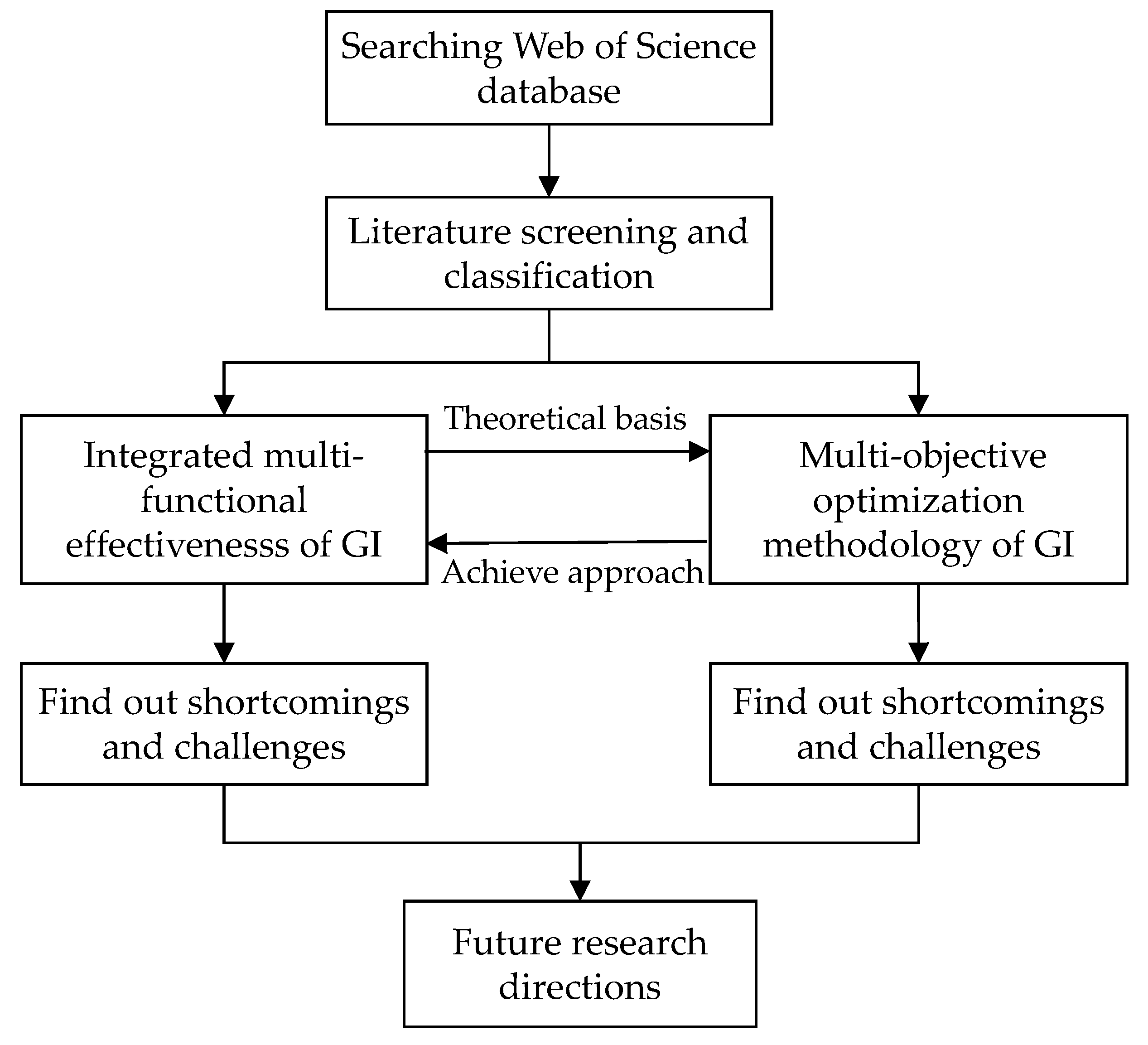
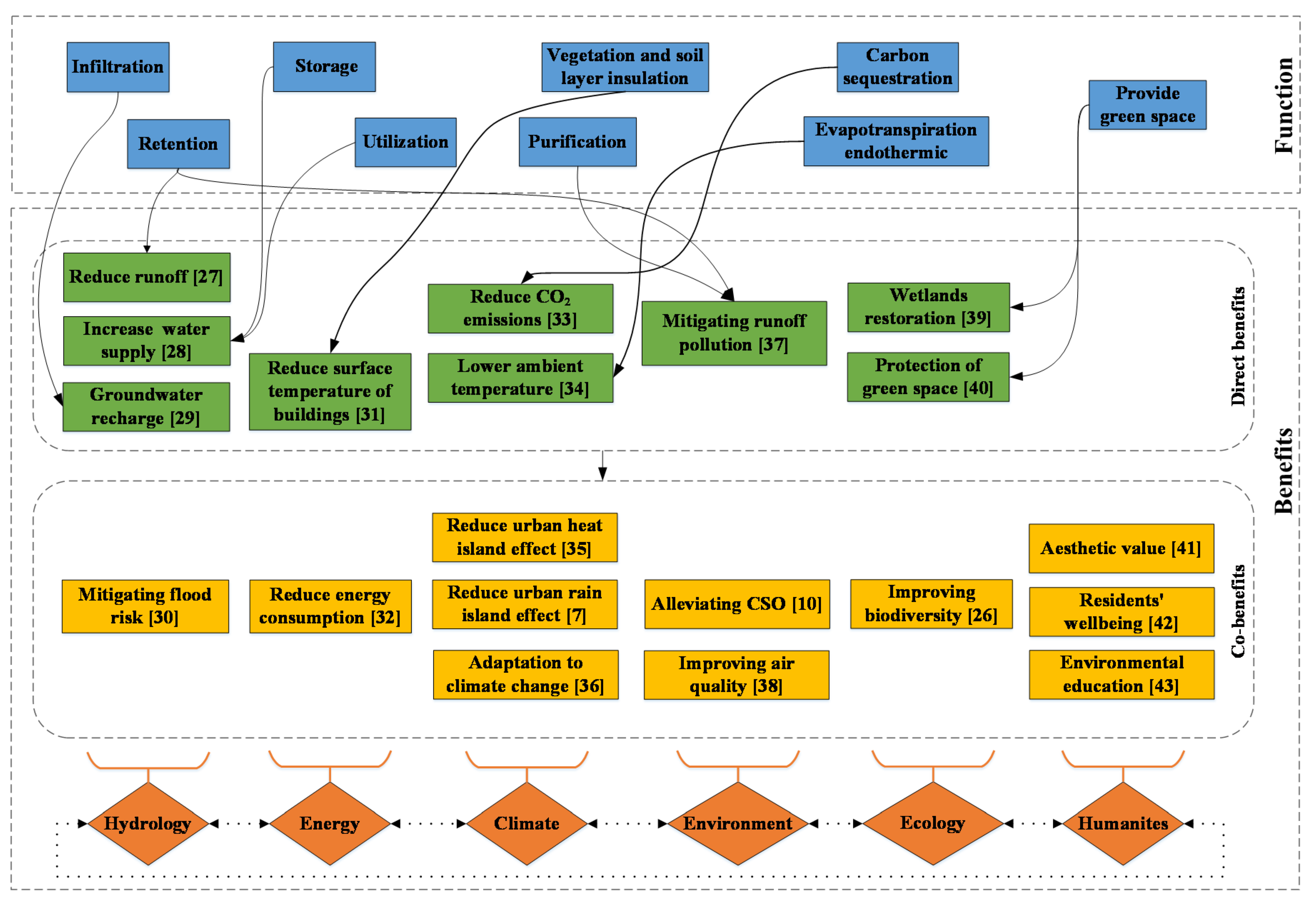

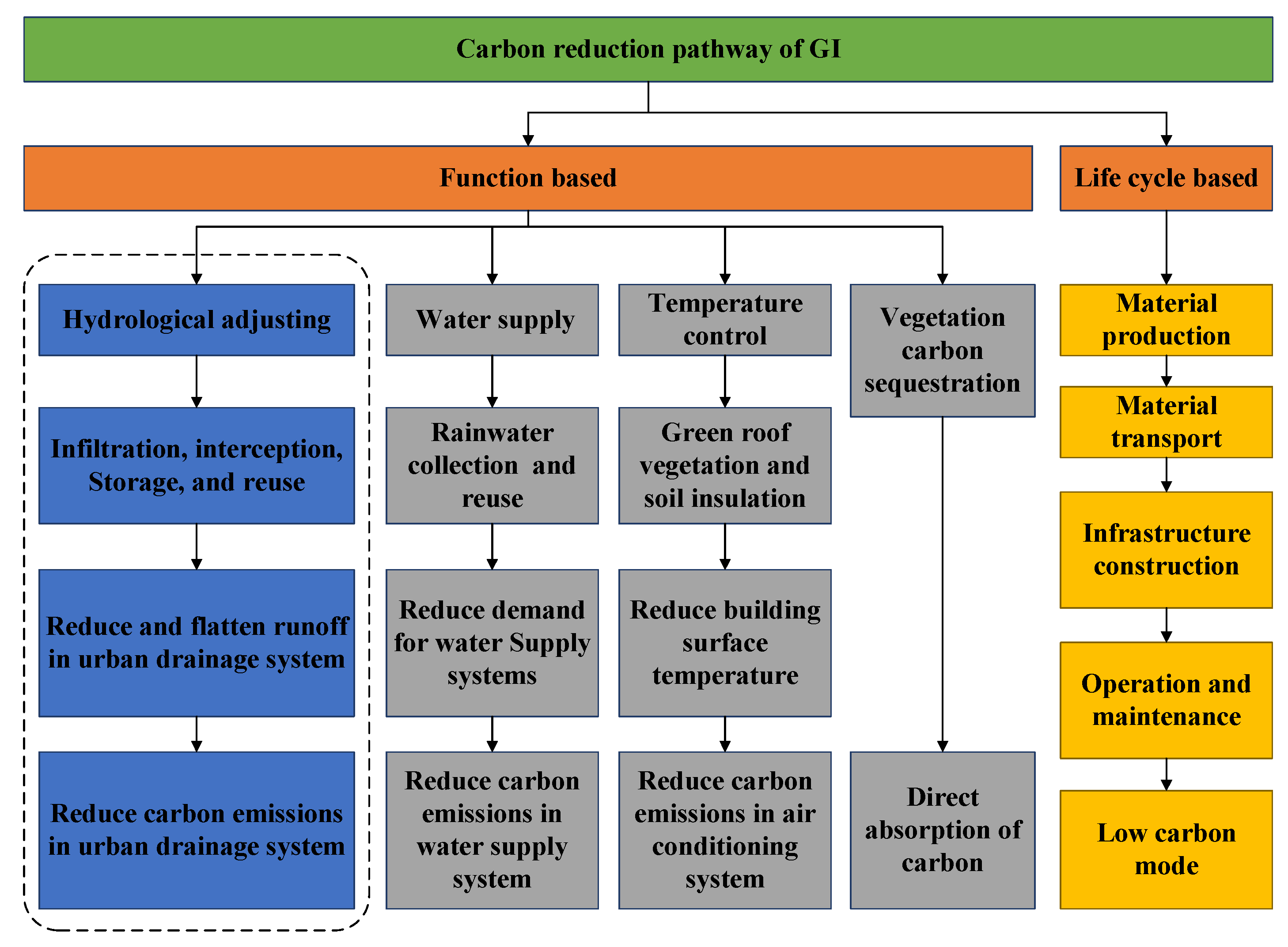

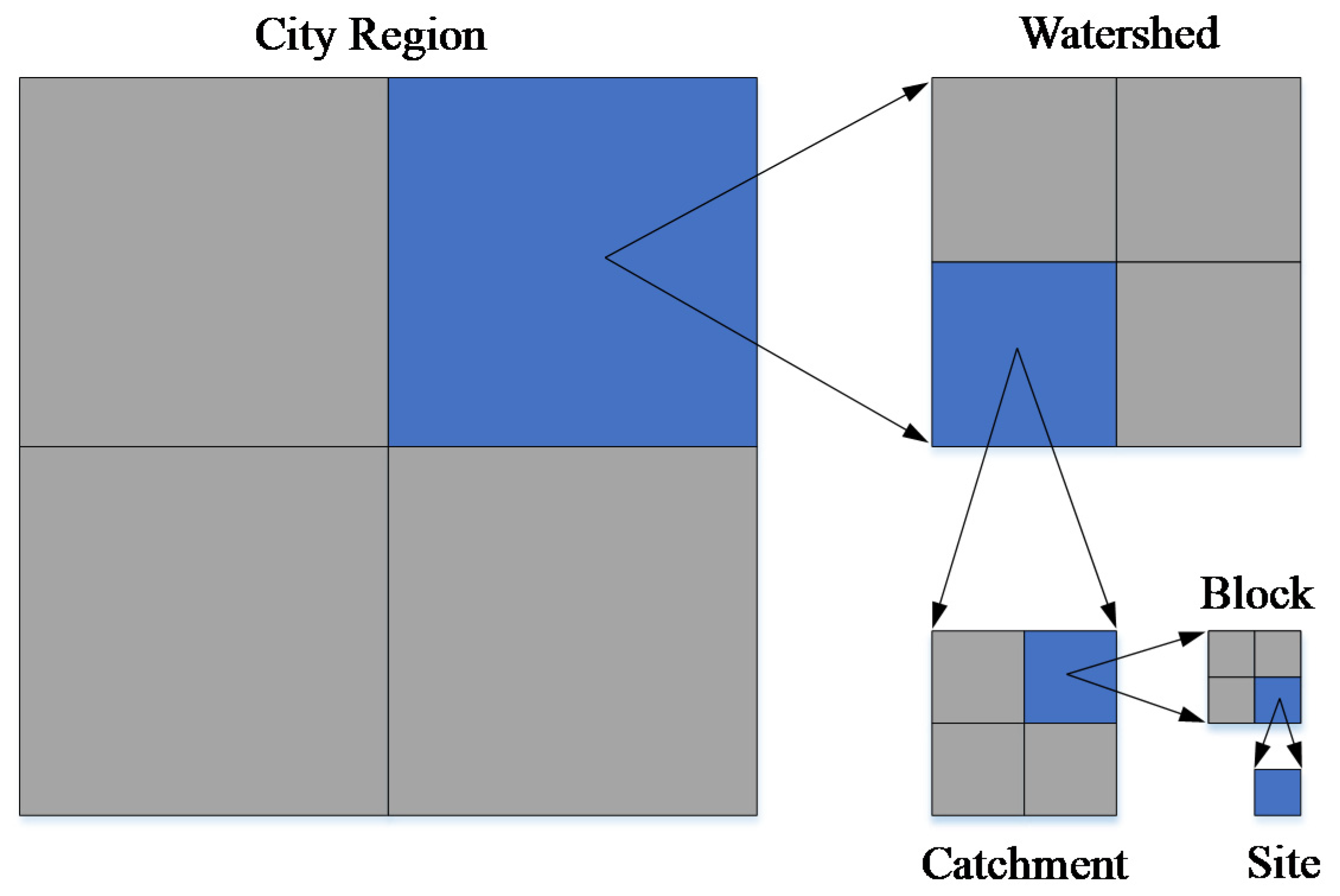
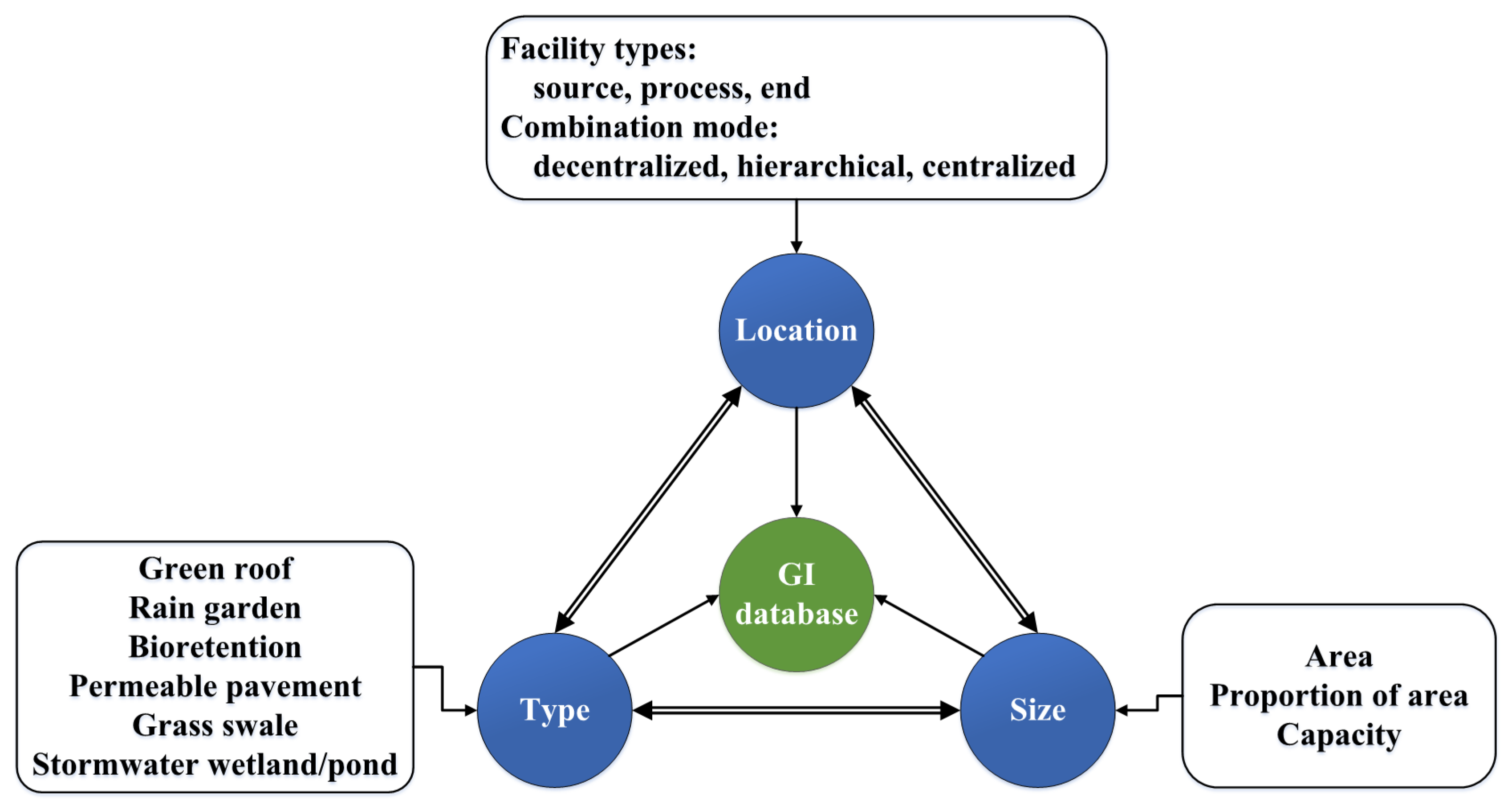

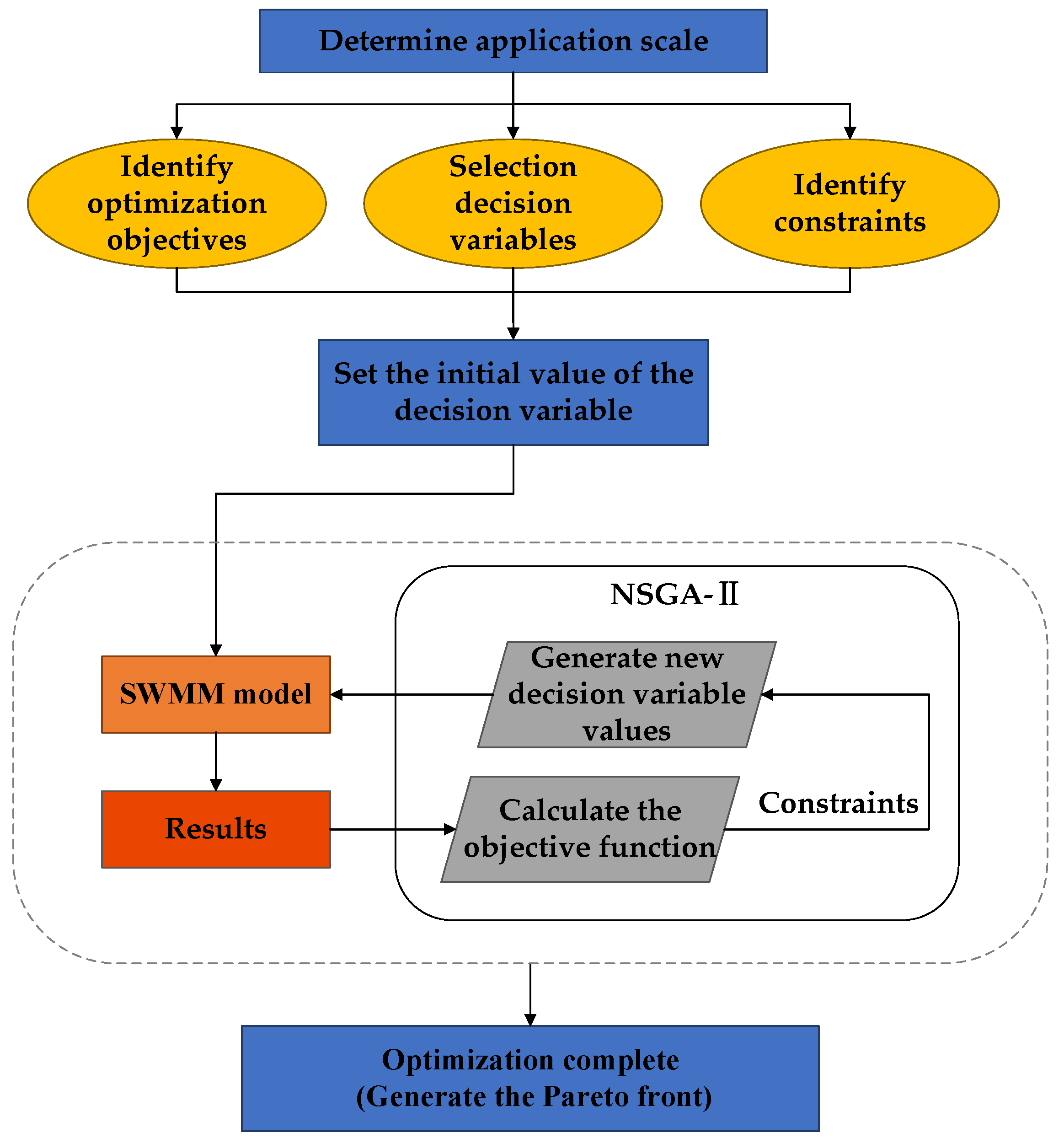

| Source | Scale | Objectives | Decision Variables | Optimization Methods |
|---|---|---|---|---|
| ○City Region ●Watershed ◎Catchment ◆Block □Site | ■Cost □Runoff Volume ▲Runoff Quality △Peak Flow ▼Rainwater Harvesting ▽Flood Inundation ●CSO ◎Amenity ◆Energy ◇Habitat Creation | ● Type ◎ Size ○ Location | ||
| Baek et al. [83] | □ | ■ □ ▲ △ | ● ◎ ○ | Scenarios |
| Montaseri et al. [84] | ◆ | ■ □ ▲ | ● ◎ ○ | GA |
| Yang and Best [80] | ● | ■ ▲ | ● ◎ ○ | NSGA-II |
| Chen et al. [37] | ● | ■ ▲ | ● ◎ ○ | NSGA-II |
| Ghodsi et al. [27] | ● | ■ □ ▲ | ● ◎ ○ | NSGA-II |
| Jayasooriya et al. [85] | ◆ | ■ ▲ | ◎ | Scenarios |
| Liu et al. [67] | □ | □ ▲ | ● ◎ | AMALGAM |
| Liu et al. [86] | ● | ■ □ ▲ | ● ◎ ○ | AMALGAM |
| Mao et al. [82] | ◎ | ■ □ ▲ △ | ● ◎ ○ | SUSTAIN |
| Marchi et al. [28] | □ | ■ ▼ | ● ◎ | NSGA-II |
| Sebti et al. [87] | ● | ■ □ △ | ● ◎ ○ | LP |
| Sun et al. [69] | ● | ■ △ | ● ◎ ○ | SUSTAIN |
| Aminjavaheri and Nazif [76] | ◎ | ■ □ ▽ | ● ◎ | NSGA-II |
| Cano and Barkdoll [75] | ◎ | ■ □ | ● ◎ ○ | Scenarios |
| Di Matteo et al. [88] | ◎ | ■ □ ▲ ▼ | ● ◎ ○ | NSGA-II |
| Fan et al. [89] | ● | ■ □ | ● ◎ ○ | SUSTAIN |
| Giacomoni and Joseph [90] | ◎ | ■ □ ▲ ▽ | ● ◎ ○ | NSGA-II |
| Liu et al. [91] | ● | ■ □ ▲ | ● ◎ ○ | AMALGAM |
| Li et al. [92] | ○ | ■ □ ▲ ▼ | ◎ | NSGA-II |
| Wang et al. [93] | ◎ | ■ ▲ ▽ | ○ | GPS |
| Xu et al. [94] | ◆ | ■ □ ▲ △ | ● ◎ | NSGA-II |
| Dai et al. [95] | ● | ■ ▲ | ● ◎ ○ | GA |
| Azari and Tabesh [77] | ◎ | ■ ▽ | ● ◎ ○ | NSGA-II |
| Eckart et al. [96] | ◎ | ■ ▲ △ | ● ◎ | GA |
| Huang et al. [30] | ◆ | ■ △ ▽ | ● ◎ | SA |
| Jayasooriya et al. [97] | ◆ | ■ □ ▲ △ ▼ ◎ | ● ◎ | TOPSIS |
| Li et al. [98] | ○ | ■ ▼ ◆ | ● ◎ | NSGA-II |
| Macro et al. [81] | ◎ | ■ ● | ● ◎ ○ | OSTRICH |
| Xu et al. [99] | ● | ■ □ ▲ △ ▼ | ◎ | Greedy |
| Yang and Chui [100] | ◎ | □ △ ▽ ◆ ● | ◎ | RPE |
| Alamdari and Sample [101] | ● | ■ □ ▲ | ● ◎ | NSGA-II |
| Di Matteo et al. [53] | ◎ | ■ ▲ ▼ ◎ | ● ◎ ○ | ACO |
| Helmi et al. [102] | ◎ | ■ □ △ | ● ◎ ○ | BFS |
| Liu et al. [103] | ◎ | ■ ▲ | ● ◎ | SFLA |
| Luan et al. [104] | ◎ | ■ □ ▲ △ | ● ◎ | TOPSIS |
| Radinja et al. [58] | ◎ | ■ ● ◎ ◇ | ● ◎ | Scenarios |
| Torres et al. [105] | ◆ | ■ □ ▼ | ● ◎ ○ | LP |
| Wang et al. [106] | ◎ | ■ □ ▲ | ● ◎ ○ | LP |
| Xu et al. [70] | ○ | ■ ▲ | ◎ | Greedy |
| Ghodsi et al. [107] | ● | ■ □ | ◎ | GA |
| Geng et al. [108] | ● | ■ ▲ | ● ◎ ○ | NSGA-II |
| Latifi et al. [74] | ● | ■ □ ▲ | ● ◎ ○ | ANN |
© 2020 by the authors. Licensee MDPI, Basel, Switzerland. This article is an open access article distributed under the terms and conditions of the Creative Commons Attribution (CC BY) license (http://creativecommons.org/licenses/by/4.0/).
Share and Cite
Wang, J.; Liu, J.; Wang, H.; Mei, C. Approaches to Multi-Objective Optimization and Assessment of Green Infrastructure and Their Multi-Functional Effectiveness: A Review. Water 2020, 12, 2714. https://doi.org/10.3390/w12102714
Wang J, Liu J, Wang H, Mei C. Approaches to Multi-Objective Optimization and Assessment of Green Infrastructure and Their Multi-Functional Effectiveness: A Review. Water. 2020; 12(10):2714. https://doi.org/10.3390/w12102714
Chicago/Turabian StyleWang, Jia, Jiahong Liu, Hao Wang, and Chao Mei. 2020. "Approaches to Multi-Objective Optimization and Assessment of Green Infrastructure and Their Multi-Functional Effectiveness: A Review" Water 12, no. 10: 2714. https://doi.org/10.3390/w12102714
APA StyleWang, J., Liu, J., Wang, H., & Mei, C. (2020). Approaches to Multi-Objective Optimization and Assessment of Green Infrastructure and Their Multi-Functional Effectiveness: A Review. Water, 12(10), 2714. https://doi.org/10.3390/w12102714







